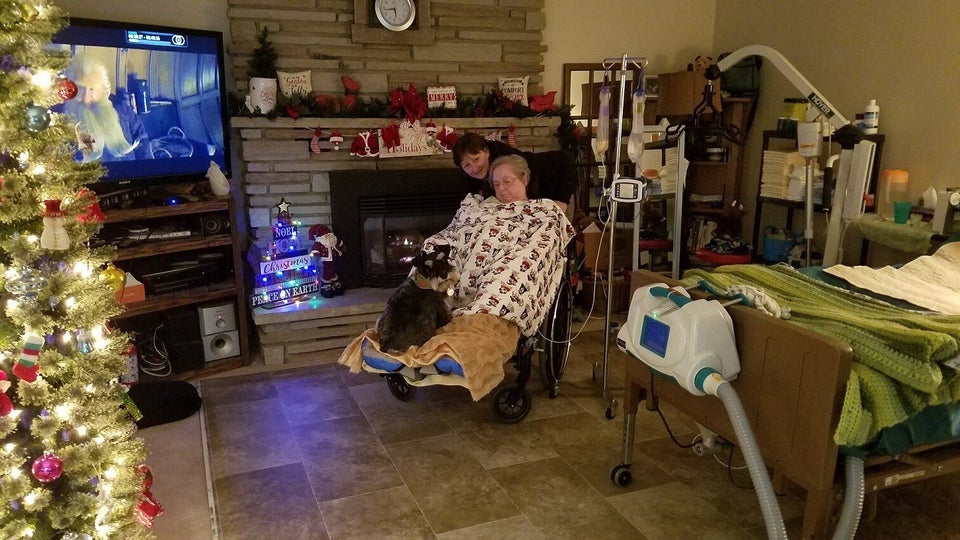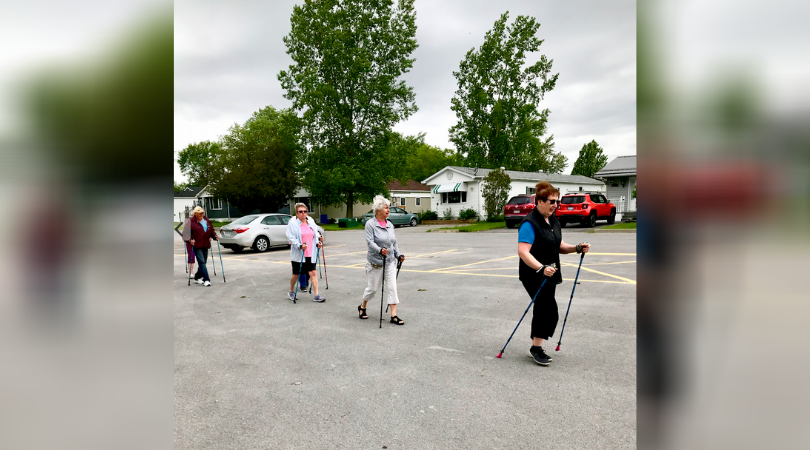Long-Term Care Is ‘Dangerous.’ What’s Ontario’s Plan For Alternatives?
Posted: December 26, 2020
(December 25, 2020)
By: Sherina Harris, HuffPost
Canadians want to age at home. Will the pandemic help them get support?
Every night for the last five months, Robin Nelson has laid down to sleep beside her mom Ann’s hospital bed, on the couch in her living room.
In August, Ann was sent to hospital — for the second time during the pandemic — and found to be dehydrated. When the hospital tried to discharge Ann, Nelson refused to have her sent back to the long-term care home, Extendicare Lakefield, north of Peterborough, Ont., where Nelson believed her mom wasn’t receiving adequate care.
So she brought her home.
Providing home care wasn’t new to Nelson. Before Ann moved into Extendicare in July 2019, she had been at her daughter’s home for three-and-a-half years. Nelson said she eventually became burned out, unable to keep taking care of her mom — the supplemental help from home care often unreliable and poor quality.
“The only option is long-term care, in Ontario. There’s no other option,” Nelson told HuffPost Canada.

Robin Nelson and her mother Ann at home.
But Ann’s health deteriorated in the long-term care home, her daughter said. After being there for three months, Ann was put in a wheelchair and stopped talking. She suffered a third, “debilitating” stroke in November 2019.
A spokesperson for Extendicare said the company does not comment on specific circumstances surrounding residents or their families for privacy reasons, but said the Lakefield home is a close-knit community where staff care deeply about the residents they care for.
“We can only respect the family’s choices for the care of their loved one and we wish them only the best in the future,” the spokesperson said.
Although Nelson had taken care of her mom at home before, her needs have become more complex. She uses a lift to get Ann in and out of bed and into her wheelchair for the day. She’s had to learn to give her mom medications through her gastrostomy tube.
Although Ann is eligible for home care through her local health integrated network (LHIN), Nelson said there aren’t enough nurses and personal support workers to cover all the shifts. When they can’t come, the responsibility falls on the family to find support elsewhere — from an agency, privately hired help or a family or friend.
“Why aren’t there more options, other than just an institution?” she asked.
Experts say that question is critical to consider as the COVID-19 pandemic exposes faults within Ontario’s long-term care system, and as Canada’s baby boomers grow older.
Canada currently spends 1.3 per cent of its gross domestic product on long-term care, below the average of the 37 countries in the Organization for Economic Cooperation and Development (OECD), which is 1.7, according to one recent report from Queen’s University researchers. The 0.2 per cent this country spends on home care is one of the lowest allocations in the OECD, the report also states.
While experts say Ontario has put some funding into other programs and is rightfully focused on its pandemic response right now, they believe there needs to be a greater focus on preventative measures and a fulsome model of alternatives to long-term care, including expanding home-care programs.
“As Ontario’s population ages, we are focusing on how we arrange publicly funded programs and services to better meet the demands of an aging population,” a spokesperson for the provincial government told HuffPost.
The Ministry of Health is committed to supporting seniors to stay at home longer — “where they would rather be,” the spokesperson noted — which they said will reduce the strain on hospitals and long-term care homes.
Ontario has proposed a “cross-government strategy” to support older adults to age at home and will have more details soon, the spokesperson said. The province gave $155 million last year to expand home care, and is “creating a 21st century” long-term care system with more capacity for people who need it.

Demonstrators protest against Bill 175, the province’s home care legislation, outside Queen’s Park in Toronto on Tuesday June 23, 2020.
he spokesperson also pointed to Bill 175, the Connecting People to Home and Community Care Act, which they said, once proclaimed as law, would help Ontario Health Teams deliver more innovative home-care models.
That legislation has been criticized by both families of long-term care residents and the Ontario Health Coalition, which said the bill would reduce oversight of publicly funded home care and give more power to private, for-profit providers. The bill “does nothing” to address issues with missed home care visits and staffing shortages, the organization said.
Canadians want to age at home
Canada’s system currently focuses on “warehousing older people” in long-term care homes, Dr. Samir Sinha told HuffPost. That comes at a cost, added Sinha, who is the director of geriatrics at Sinai Health and the health policy research director at the National Institute on Ageing (NIA) at Ryerson University.
Patients designated as “alternative level of care,” those who are either waiting to go to a long-term care home or to return to their homes with government-funded supports, currently occupy 15 per cent of hospital beds across the country.
“They actually have their own bed. They want to go home. The hospital believes they can go home. Home care believes they can go home. But it takes two weeks before we actually can get home-care services in place, because that’s an example of how short we are on providing home care in certain regions,” Sinha said.

St. Michaels Hospital in Toronto on Oct. 21, 2020.
Almost 100 per cent of Canadians aged 65 and older plan to age independently in their own homes, according to a survey by the National Institute of Ageing and TELUS Health. Nearly 70 per cent of that same age group said the pandemic has changed their opinion on whether they’d want to put themselves, or a loved one, in a nursing home.
“There are very few people waving their hand and asking to go to long-term care,” said Don Drummond, the Stauffer-Dunning Fellow at Queen’s University and co-author of a November report called “Ageing Well.”
He said Canadians would “overwhelmingly prefer” to age in place, whether that means in their home independently or with support, or another form of community living in an area that’s familiar to them.

A COVID-19 positive resident, identified as Flora, sits with a member of staff after receiving an absolution from a priest, at Orchard Villa Care home, in Pickering, Ont. on April 25, 2020.
Drummond was also part of a group of experts who spoke to Ontario’s long-term care commission in November, urging the commission — which has so far focused on the need for immediate changes to the province’s long-term care system — to consider the larger context.
Canada would need 250,000 to 300,000 new long-term care beds by 2041, and even more if the goal was to eliminate the wait list for beds, Drummond said.
“I firmly believe that that will not happen,” he said. “And so we have to now start to prepare for alternatives — and yet, we’re not.”
Looking to alternatives
One in nine long-term care residents could have been cared for at home, a 2020 analysis by the Canadian Institute for Health Information found.
It costs between $212,000 and $268,000 to build a new long-term care bed in Ontario, Sinha said. And caring for a resident in a nursing home costs about $200 per day, whereas caring for someone at home is about $103.
Sinha is part of a team proposing an alternative model that takes the daily cost to care for someone in a nursing home and allows local community groups, such as the Ontario Health Teams, to provide a mix of government-funded home care and other community services, such as delivered meals and transportation services. This model would allow health-care providers to work together and share a patient’s record and care plan.
“Frankly, when you’re missing one of these four components, then it’s like having a two-legged stool.”
– Dr. Samir Sinha
Individuals at home still need adequate primary care, Sinha said, which may be a mix of home appointments, virtual care or going to a clinic in person. Community paramedics also play an important role in providing around-the-clock care either for an urgent response or wellness checks.
Sinha submitted a report about the model to the province in 2019. Ontario recently announced it would give $15 million to expand its existing community paramedicine program, but has not announced funding for the other components.
That investment could “fall short of the ultimate goal of trying to help people stay in their homes for as long as possible,” Sinha said.
While community paramedics play a role in helping people living at home, they’re only one part of the multi-step process proposed to ensure an integrated team is caring for an individual at home, he said.
“Frankly, when you’re missing one of these four components, then it’s like having a two-legged stool. It doesn’t work,” he said.

Ambulances at Brampton Civic Hospital.
Rob McMahon, a spokesperson for the Ministry of Long-Term Care, said the community paramedicine program will help families and caregivers have peace of mind and stability through 24/7 support, such as home care visits and remote monitoring.
The province has also announced $2.4 million to support 13 additional Ontario Health Teams, he said.
But giving money to one program and hoping they collaborate with others isn’t enough, Sinha said.
“The problem is, we put all this money without mandantes … and, at the end of the day, you have a woman saying, ‘It’s hard for me to get the right amount of nursing.’ And that’s why we ended up having 40,000 people on the waitlist, when we have over 150,000 people in Ontario with unmet home care needs.”
“I actually think we could support far more people to age in their own homes, where they want to be.”
– Dr. Samir Sinha
He said new funding isn’t necessarily needed, but existing funds need to be better coordinated.
“I actually think we could support far more people to age in their own homes, where they want to be,” he said. “And frankly, we would actually take a huge amount of pressure off the need to build a number of beds that we may not even need in the first place.”
Sinha said there are also challenges with staffing that need to be addressed for any alternative model to work.
The provincial spokesperson said Ontario has a “range” of initiatives to recruit and retain personal support workers. It also implemented temporary wage increases for home and community care workers, as well as long-term care home staff. The Ministry of Health announced in September it would use $8 million to add more than 800 nurses to the province’s health-care system, including home and community care.
Self-managed home care ‘growing exponentially’
Not only do more people want to live at home, but the pandemic highlighted living at home may be a safer option for seniors, Christine Kelly, an assistant professor in community health sciences at the University of Manitoba, told HuffPost.
“We have to start saying this, that residential long-term care homes, it’s becoming clear, especially the privately owned and operated ones, for-profit ones, are dangerous,” she said.
Kelly is an expert on self-managed home care — also called directly funded care — a program born out of the work and advocacy by disability activists pushing for more control over the services they received.
In self-managed home care, a person is given money to arrange their own services.
“Sometimes people are driven to it because of frustration with the mainstream program, and sometimes people are driven to it because they want that control and flexibility,” she said.
It’s available in all Canadian provinces and, although it’s a more niche option right now, it’s “growing exponentially,” Kelly said.
She said the program works particularly well for younger people with physical disabilities, but there’s emerging evidence older people and those living with dementia also like the flexibility and control.
It allows for more shifting to the social side of care — like helping with a family’s laundry, walking a dog or clearing snow off the driveway — and gives people the options to choose workers who might speak the same language as them or who are a good personality match.
“… It’s probably something that we could learn in regular home care, to kind of make allowances for that rather than sort of ban these types of activities,” she said.
In some provinces, such as Manitoba and Alberta, it’s one of the options presented to people when they’re assessed for home care.
In Ontario, some seniors are eligible for the family-managed home care program if they have an acquired brain injury or are in exceptional circumstances, a government spokesperson said.
The spokesperson said the program is “still relatively new” to Ontario and has been targeted to specific groups for its early stages, but the Ministry of Health may open it up to additional groups in the future.
A program for aging communities
Another aging-in-place model leverages communities where older adults already live.
In 2011, a group of older adults in a Kingston, Ont., apartment identified a collective desire to age in place – but they also found themselves dealing with social isolation. This led to the creation of Oasis, a program that can be implemented in what are called “naturally occurring retirement communities” — small neighbourhoods or towns that have an unplanned, high proportion of older adults.
In 2018, researchers received funding to expand the Oasis program. They currently have six sites in four Ontario cities: Kingston, Hamilton, London and Belleville. Most are high-rise apartment buildings, except Belleville, which is a mobile-home community.
The first step in implementing an Oasis program is that a landlord donates space to run programs, said Catherine Donnelly, an associate professor in the health sciences faculty at Queen’s University and co-lead of one of Ontario’s Oasis projects. That could even be as simple as a library donating space for a community instead of a room within an apartment building, she said.
The next step is hiring a coordinator who helps facilitate programming. That could be a barrier to implementing Oasis programs on a wider scale, Donnelly said, since it’s where there’s more of a cost.

Members of an Oasis community in an undated photo.
The expansion sites received funding from municipalities, the province and Baycrest hospital’s Centre for Aging and Brain Health Innovation. The funding from those sources has now ended. Three programs still receive local funding, and the rest are being supported by students and volunteers, Donnelly said.
Finally, it’s important that the people in a community actually want this model to be implemented, she said.
A key feature of Oasis programs is that it’s not simply akin to a “cruise ship” set of activities imposed on older adults, Donnelly said.
Instead, at monthly meetings members can suggest activities they want to see — or even lead themselves. Before the pandemic, there were activities almost every day in Oasis communities: from morning coffee and communal cooking or eating, to exercise classes, such as seated yoga and a popular line-dancing group.
“A lot of members said that … their schedules were so busy, they had to kind of pick and choose what they wanted to do,” said Simone Parniak, the research project manager for the Oasis expansion project.
Another popular activity, she said, was a monthly series of guest speakers, such as pharmacists, dieticians, a representative from Canadian Hearing Services and a person from an elder law clinic, who spoke about services they could provide older adults. This is now being offered by phone and online because of physical distancing requirements.
Members create ‘family relationships’
Oasis focuses on three main areas: physical activity and mobility, social engagement, and healthy nutrition, said Vince DePaul, an assistant professor at Queen’s and co-lead of the Oasis project.
One member-driven activity in particular stands out to DePaul. A woman in an Oasis community who is hearing impaired and was feeling isolated decided to come to an initial meeting where American sign language (ASL) interpretation was provided. She ended up running ASL classes for other members who were “very interested and committed” to learning, DePaul said.
Another member who was mobile enough to go to an event in their community attended a creative writing class, and then later taught a class to Oasis members.

Oasis members painting in an undated photo.
Oasis members delayed going into long-term care for one year, on average, compared to people not in the program. Older adults in Oasis buildings also relied less on home care.
Fewer people have reported being lonely, and more were physically active, other data shows. There were also fewer falls among Oasis members — an important factor, DePaul said, because falls are a major health risk for older people that can lead to more serious injuries and institutionalization.
“In every building that we’ve been involved in, the people spoke about being in this building for a number of years, and not knowing their neighbours,” he said. “And because of a more structured approach that Oasis brings, people were developing these friendships and actually more like family relationships that they speak of.”
When asked about the province’s plans to support Oasis programs, the government spokesperson did not directly answer, but said the province has taken steps to support other innovative housing approaches, including those that help seniors.
A preventative approach to frailty
Part of planning for alternatives may also require a shift in the way we think about aging.
Frailty — a state of increased vulnerability and loss of function — and dementia are not inevitable parts of aging, John Muscedere, a professor of critical care medicine at Queen’s University and the scientific director of the Canadian Frailty Network, told HuffPost.
“If we adopted a more proactive approach to the maintenance of function, I think we can actually flatten the curve, for both the occurrence of frailty and dementia,” he said.
“It’s not going to happen overnight.”
– John Muscedere
That would mean taking a more preventative, public health promotion-based approach, Muscedere said, including promoting exercise, ensuring seniors take optimized medicine — not too many medications, and not too few — reducing social isolation and ensuring people have access to adequate nutrition and vaccinations.
Muscedere said he’s optimistic changes will happen. For one thing, as the number of aging Canadians increases, they will demand a better model of care, he said. And we can’t afford to keep building long-term care beds, knowing it is a worse quality of life for residents.
The Canadian Frailty Network is pushing for public health units to adopt more of a preventative approach to aging, which has been so far well-received, he said. It is also developing regional centres for health aging, where this approach would be the main focus.
“It’s not going to happen overnight,” Muscedere said. “But I think we need to have this long-term vision in place and I’m fairly optimistic that we’ll get there.”


